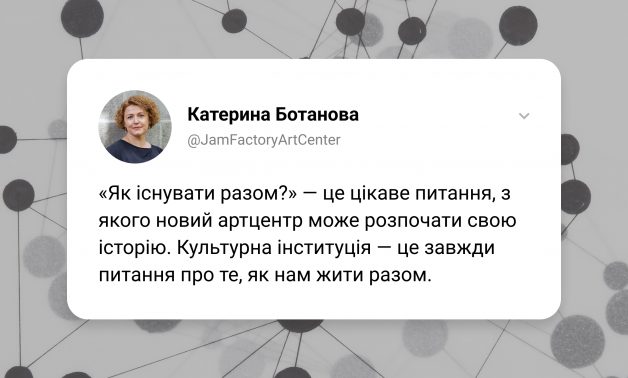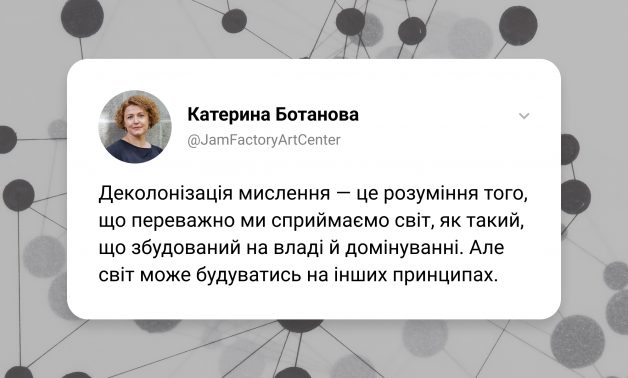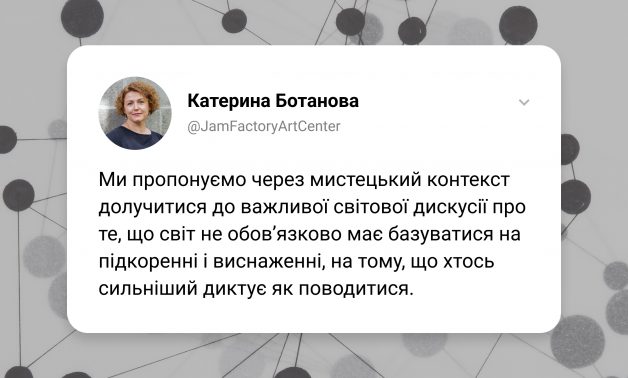In August, the Jam Factory space in Lviv revitalization to be completed. The team and invited curators are preparing the Organic Communities Program prior to opening. This program will include an exhibition, theatre, music and discussion programs.
Kateryna Botanova is the main curator of the Jam Factory Art Center opening program, cultural critic, publicist, co-curator of the CULTURESCAPES Cultural Festival in Basel, Switzerland.
Kateryna, in her interview to Liudmyla Liakhevych (Radio Culture), lifts the veil on preparation for a large-scale project and explains why the issue of community interaction is so important today for Ukraine and the world.
Kateryna, please, tell us in more detail about organic communities? Who are they? How should we understand this?
A good question to start. I don’t know who the organic communities are. All of us exist in various intersecting communities. The question of “What is a community?” is a question to everyone regarding the way we interact with each other and with the environment.
The question of “How to exist together?” is quite an interesting one the new art center can start its history with. A cultural institution is always about the way of living together, joining, discussing, and disagreeing, about how to build interesting stories out of different disagreement and opinion formats.
In fact, Organic Communities as a Jam Factory Art Center project is a three-month program covering an exhibition, theatre, music and performance blocks. The project includes anthology creation, offline and, hopefully, online conferences and an extensive educational discussion program.
How did “Organic Communities” emerge? How did the idea come up, and how did you become a team member?
Initially, an idea has come up in 2015 of Jam Factory Art Center opening in the revitalized Jan Factory space. A great idea Centre’s team has been implementing for 7 years. It’s a bit fantastic to imagine it actually implements this year. Last year, Harald Binder, the founder, and Bozhena Pelenska, director, announced ideas and concepts competition for the opening, invited me to participate and picked up my idea.
I proposed to build up a curatorial team, as, to some extent, the Organic Communities opening program is a proto-institutional project. Jam Factory Art Center sets an ambitious task. Center will provide theatrical, musical, and exhibition programs, work with different audiences: support professional artistic environment in Lviv and attract wide audience, make international projects, build various interactions and dialogues between Ukrainian and non-Ukrainian contexts. The first project should reflect all these aspects. Therefore, it was obvious that not a single person, but a curatorial group should create it There are five of us in the team (Kateryna Botanova’s comment, Olha Bekenstein, Liuba Ilnytska, Oksana Karpovets, Ksenia Malykh), all of us have very different experiences, we work with different disciplines, and we build this three-month program together.
Thinking decolonization is a term we see in the curatorial text. What is it about and how should we perceive it?
Thinking decolonization means an attempt to look at today’s world and understand it in a way radically different from what we are used to. Adam Shymchyk, Documents 14 curator, used the idea of “unlearning” to develop his concept. This means not only moving away from patterns but also understanding the basis of knowledge of ourselves and the world and thinking whether this way of knowing and interacting with the world makes it better.
Thinking decolonization is an understanding of us perceiving the world mostly as built on power and domination. Even the way Ukraine perceives today its place in the world and its political situation. We are always between different areas of tension, and we understand that living standards and basic decisions are made somewhere else. The world division into superior and inferior, stronger and weaker exists on many levels, not only at the political one, but also at the level of everyday interaction: someone is stronger, someone is richer, and someone has more power.
We would like to involve through the artistic context in an important global debate that the world does not have to be based on conquest and exhaustion and that someone stronger dictates how to behave. People in micro and macro communities can interact on completely different principles, which principles include mutual respect, equality, care, and symbiotic relationships when different parts of our world are interdependent. However, this dependency does not exhaust or kill; it is a dependence on mutual support. For example, just as different particles coexist in nature, so the human community can be organic, and mutually supportive, such that strengthens the components instead of destroying.
Not a natural selection…
The idea of natural selection comes from ideas about the nature of a society having a linear development, where the strongest has to survive. However, in fact, it is much more complicated and interesting with nature. The same is true for human society where it can also be more complicated and interesting.
The exhibition builds dialogues between five zones: helplessness, care, cultural memory, new ecosystems and multiple futures. Why did you choose these topics?
For me, any exhibition is a certain story. Curators always encounter challenges of how to tell a story via visual art, which is non-linear, and multidimensional, but still needs to develop for a viewer into a story or a polyphonic plurality of stories.
Jam Factory space is very interesting and challenging, it includes many spaces with different stories and of various scopes. How one should tell and show this story in a space divided into parts? In addressing this issue, the curators and I thought that the story could unfold and pass through these halls as if guiding the viewer.
Why did we start thinking about organic communities in today’s world? We had the challenge of developing an international project that would combine Ukrainian and non-Ukrainian experiences. Then we realized that a pandemic could become such a consolidation point and journey start – an experience that we have all had and still have.
The pandemic revealed and emphasized strongly the condition of our existence fragility, our strengthlessness and our helplessness. Accordingly, we started our thinking story with questions, “What is an organic community? How can we, human beings, be together? Where are we today? What can be done about this helplessness?” Accordingly, care is the second part of story, as only mutual support and care, mutual act of strengthening oneself and others can promote us with getting out of this disunity and helplessness into another dimension and another system.
Let’s go back to helplessness. How will you demonstrate it? When I come to the Jam Factory Art Center as a visitor, what will I see, and how should I perceive it?
I can’t tell you yet. There are different types of exhibitions. For example, those that start with specific works of art or specific artists, then one can talk about what the visitor will see. In our situation of an interdisciplinary project, we start with a story, with a curatorial concept. In fact, we will be able to tell about what one will see, specific artists, how they will combine with each other – in a few months.
However, do you have any templates? Do you already know everyone’s task?
Yes, of course. Nevertheless, it takes a little longer to talk about it. The most interesting thing is that visitors will be able to see very different artists telling in different forms and formats about their vision and experiences of helplessness, anxiety, rethinking memory and interaction systems.
These will be the artists from Ukraine only, or not?
This is an international project. Art projects, theatre productions will be very different. Not only Ukrainian ones.
We’ve touched upon care. So, what the “cultural memory” block will tell about?
Cultural memory is one of this project’s cornerstones, and the Art Center will work on this topic anyway in the future. Jam Factory space replete with complex, interesting story. That part of Lviv, where the factory locates, has many historical intersecting layers. This heritage will obviously push the cultural institution to advert to the memory in different ways.
Our project is about presenting or prototyping the future. However, we cannot talk about the future without looking at the past, without re-assessing its role in who we are today. This is of particular importance in the Ukrainian context. A cultural memory review and an attempt to decolonize it are necessary in order to look at our heritage in terms of self-sufficiency and today presence. Do not try to measure it, evaluate according to the ready-made templates or compare it with other.
The Ukrainian history is full of interesting intertwinings, intersections and conflicts with the European history. For instance, the latest book by Yaroslav Hrytsak is exactly the point – a look at the history of Ukraine in a broader context. Being a part of the European history does not always mean something joyful and positive; it is also a responsibility for how world history has developed. Accordingly, the cultural memory for us is a part of a story that imagining the future is impossible without looking at the past.
Let’s talk about new ecosystems. What are they? What kind of ecosystems are we talking about?
Modern humanitarian thought is about a new turn one can conditionally call the “new ecologies” or “new environmental thinking”. The thing is that one can perceive a human, its role in history, not only as the ruler of nature, but as part of the world. Human is much stronger and more powerful. That is why human can change nature. However, in reality, we are part of the environment only. The division into human and nature, our confrontation and dichotomy developed in 18th-century European philosophy, are responsible largely for the ecological and climate crisis. For humanity to have a future, this way of thinking must change. People should treat themselves and the environment differently. Perhaps, just by feeling themselves as a part of nature, instead of rulers, people can try to imagine the ways of saving planet, because it already needs to be saved. The planet itself will not be able already to recover.
The art reflects this view of human interaction with environment in an interesting way. Many artists are working on this. Today, this is one of the main themes in various projects and exhibitions worldwide. Our story of thinking about organic communities assumed it very important to show what such interaction can be through the art.
We would like to see other opportunities for interaction, other future out of helplessness, through care, rethinking cultural memory and ourselves. Part of the interaction and rethinking should take place through the new ecologies approach, other connection of different environmental actors. This is a very important issue for Ukraine in particular, because Ukraine’s environmental and climatic situation is challenging. There is a lack of talks and writings about it, as it should be, because Ukraine encounters many other problems. However, this does not change or improve the situation.
Will the program address an environmental issue?
Yes, we are currently collaborating with several artists on new works, specifically for this project section, which will address environmental issues in the Ukrainian context.
Multiple future. Through the line of ecology, we move on to the future.
Multiple futures are my most difficult and favourite part of the exhibition, because I strongly believe in the visionary function of art as a way to imagine what has not yet been imagined; trying to think of something that does not yet exist, or that may exist differently. To some extent this is utopian story, I like the utopian element in art.
It is interesting to look how the global art handles closely the very acute and painful issues of today. How close the contemporary art is to the avant-garde of the last century. Art as an action, as a direct step, as an intervention, as a belief that artistic gesture and artistic remarks can change the present and, accordingly, the future.
Program educational component – does it mean discussions or, perhaps, separate lectures in order for visitors to communicate more and immerse themselves into topics that are important now, in particular, for Jam Factory Art Center and relevant to our country.?
The educational program will embrace several components. We are preparing a discussion section that is open to everyone, but rather focused on the professional community: art, theatre, humanitarian in general. There we would like to talk about the theoretical basis of new ecologies and thinking decolonization. We will offer those topics that are very important in the Ukrainian context and widely discussed worldwide.
For a wider audience, ordinary connoisseurs of art, who are not very interested in the theoretical component, but interested in exhibition – we will have guides, audio guides, and special workshops. We will try to tell every visitor about the works presented at the exhibition. How to look at these, what one needs to know to understand these works better, how these works conjoin together. We are going to add some stories that are not obvious and lift the veil on.
How the program will combine different art movements? Will the events take place on different days, or will it be fragmentary?
Let me remind you once again that the program will last for three months, and it is a long time. The exhibition will open together with the Jam Factory space opening and will be open for visitors for three months. The theatrical and musical programs will be implemented in a certain rhythm. For example, per month, we are planning several different events to be combined with a common theme. Our theatre and music curators also work with the idea of organic communities. We will show the way different musical and theatrical productions and directors approach the issues of interaction and the way the future of human communities can be.
Were there any suggestions or challenges in the team, with regard to communication with international experts, and foreign artists?
The main challenge is that we keep working with the space under construction.
Did the artists ask what the building of the Jam Factory is?
Of course, everyone always asks, especially the artists. For them, it is important to see the space in their artwork to be presented even if it is not a new one. Creating a project and exhibition for a space that does not yet exist is an interesting and difficult challenge. We are witnessing the wall’s growth. The main part of the work should be completed in the nearest future. However, during the last year, there was no space while we negotiated with artists.
What are your audio guides’ languages? That is, apart from Ukrainian visitors, will it attract foreign visitors too?
We will have it in Ukrainian for sure, as for English, I would very much like to hope for it, at least we are planning it. The printed exhibition guides will be bilingual, as well as the exhibition catalogue, I hope the audio guides too. Part of the Jam Factory Art Center ambitions is to be a cultural hub attracting very different guests of Lviv. It will be fantastic.




